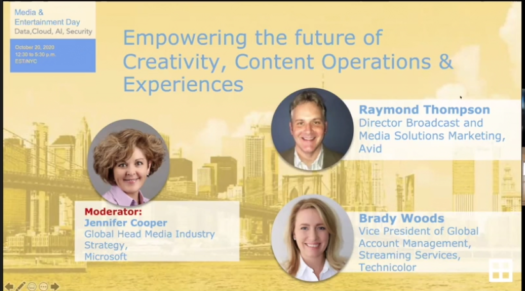
How the Cloud Has Helped M&E Companies Overcome COVID-19 Challenges
Cloud technology and tools from Microsoft Azure, Technicolor and Avid Technology has significantly helped media and entertainment companies overcome challenges created by the COVID-19 pandemic.
Their technology has enabled remote collaboration, content production, editing and the ability to provide personalized experiences to deepen audience engagement, executives from the three companies said Oct. 20 during the online Media & Entertainment Day event.
Kicking off the Cloud & Virtualization breakout session “Empowering the future of Creativity, Content Operations & Experiences,” moderator Jennifer Cooper, global head of media and entertainment industry strategy at Microsoft, noted the session was on “our favorite topic: remote everything.”
When Brady Woods, VP of global account management, streaming services at Technicolor, looks back on this year, she said one of her first thoughts will be: “It would have taken me three to five years to convince people to try this workflow and it took me three conversations” instead.
“Necessity being the mother of invention and COVID being the mother of adoption… I really believe we’re going to see a fast forward” when it comes to cloud and remote collaboration adoption as a result of the pandemic, she told viewers.
It was a huge positive to “see people open their mind to the idea that” remote collaboration could work, she said, noting: “It’s not only possible. It’s probable and it’s efficient and it’s a better experience.”
She’ll also look back on just how significant remote collaboration tools and Microsoft Teams have been, she said.
Echoing her, Raymond Thompson, director of broadcast and media solutions marketing at Avid, said it’s been a “huge eye-opener” for the industry that remote work from anywhere can indeed work.
 “It’s going to change the way people sort of initiate and produce content and then it’s going to change the way in which people collaborate and work together to get stuff out,” he predicted. It’ll also “lower the barrier, I think, to entry for a lot of companies that maybe in the past looked at it as too expensive to try and sort of go down that path,” he predicted, noting such concerns are “starting to go by the wayside.”
“It’s going to change the way people sort of initiate and produce content and then it’s going to change the way in which people collaborate and work together to get stuff out,” he predicted. It’ll also “lower the barrier, I think, to entry for a lot of companies that maybe in the past looked at it as too expensive to try and sort of go down that path,” he predicted, noting such concerns are “starting to go by the wayside.”
What Technicolor has been hearing from M&E customers on remote production “more than anything is… there’s a key focus on health and safety” by all of them, Woods said, pointing to how organizations are “really trying to limit person-to-person contact.”
Specifically, the film industry is trying to produce as much content as possible remotely, with as few as people as possible being on a set at any given time.
There is also “a quicker dailies process in order to get visuals in front of people who weren’t able to participate,” Woods said. It’s really a matter of “trying to streamline how it is that we get those visuals – what’s being shot on set – without having any non-essential people actually on set interacting with the pods of people” who must be there, she noted.
But Technicolor had been having conversations about accomplishing these things pre-pandemic, she noted, adding: “We’ve been talking about these remote workflows and really trying to extend video streams to teams outside of on-set locations and speed up the dailies process pre-COVID. And so that’s something that we’re really seeing as a key emphasis and a key change to production.”
Another key issue now is centralized data, she said, explaining: “We really are trying to store [data] once and have everybody collaborate on that storage as much as possible. There’s bandwidth issues obviously in terms of transferring the data around the globe. So we’re really trying to focus on how do we streamline our processes to duplicate less and to move the payload of huge files from place to place less.”
Technicolor has discussed remote workflows prior to the pandemic and “already had solutions like our software solution Pulse, which sits in Microsoft Azure as well, that allows us to extend remote access to storage,” she pointed out.
“There were a ton of productions that got all the way to the principle photography and then they were left in the middle of a pandemic trying to shift [to] remote,” she recalled, adding: “For us, being able to extend remote access to your original camera files was really key to being able to move things along the production pipeline. So that means being able to take our original camera files, push them out to visual effects vendors, be able to receive those returns – all from centralized storage infrastructure… which really allowed participants to continue to collaborate” on a global level.
“Obviously, our visual effects teams are not all based out of Los Angeles,” she noted, explaining: “Any of the productions that were working with Technicolor as a software as a solution utilizing Pulse were able to keep moving the pieces through their pipeline without any delay and they were able to do so in a way that felt streamlined and felt the same as pre-pandemic, which is I think one of the keys for the future, right?…. Really focusing on replacing the in-person experience and having that be as seamless as possible…. We want it to feel as good if not better working remotely. That’s the goal and so I think Pulse was really a way that we were able to do that.”
Another tool that has helped Technicolor achieve that is TechStream, a mobile app used for post-production, she pointed out.
And artificial intelligence will play an important role also. “AI is the next integration that I think is key for our business when we talk about our asset management tools and when we talk about indexing of original camera files,” according to Woods.
“One of the key things we really heard from our clients when production had shut down was” that they knew they had certain content that could be reused now while they couldn’t shoot new content, she noted. However, “the manual indexing of this process makes it impossible for them to manipulate their own library in a way that works for them,” so they couldn’t easily find that content.
AI, however, can be used to make searching for content in massive libraries much easier, she explained, noting that what she wants to see is studio content becoming as easy to search for as dog photos on an iPhone. She called AI a “key area of growth and opportunity” for Technicolor.
Pre-COVID-a lot of customers were thinking about moving to the cloud and were at different phases of doing so on a variety of different projects, including editorial, asset management and a combination of both across news, sports and other content, according to Thompson.
“Once COVID hit, it just sort of accelerated those timelines,” he said, adding: “Most people fell into two buckets. One was ‘we need to enable remote workforce to either get into the on-prem environment’ or ‘we need to set something up in the cloud’.”
Avid had several different Software-as-a-Service offerings that its customers were able to take advantage of based on all the work it had already been doing with Microsoft, he told viewers. Last year at IBC, Avid launched a tech preview of that and “we had a number of folks interested, [but] once COVID hit, it really skyrocketed,” he said.
Security issues created hurdles, but that’s another area where the Avid-Microsoft partnership helped, he said, explaining: “We were able to take advantage of all the work that’s already been done on the Azure stack from a security perspective, while also bolstering what we offer on the application side. It sort of convinced the studios that what you have in the cloud is safe. That was probably the biggest hurdle.”
After all, convincing studios that moving to the cloud would be safe had long been a challenge, so “the fact that we were able to convince some of the bigger studios to go ahead and make that move was a big, big hurdle to get over,” he said.
Woods went on to offer advice for everybody in the industry: “Stay curious in this moment, which is stay curious [about] what’s possible and stay open to the idea that the way you do it can be transformed in a technologically advanced way. And that we’re in it together……. Stay open-minded to how technology can be a value add to your business.”
Click here to access the full presentation.
M&E Day was sponsored by IBM Security, Microsoft Azure, SHIFT, Akamai, Cartesian, Chesapeake Systems, ContentArmor, Convergent Risks, Deluxe, Digital Nirvana, edgescan, EIDR, PK, Richey May Technology Solutions, STEGA, Synamedia and Signiant and was produced by MESA, in cooperation with NAB Show New York, and in association with the Content Delivery & Security Association (CDSA) and the Hollywood IT Society (HITS).
